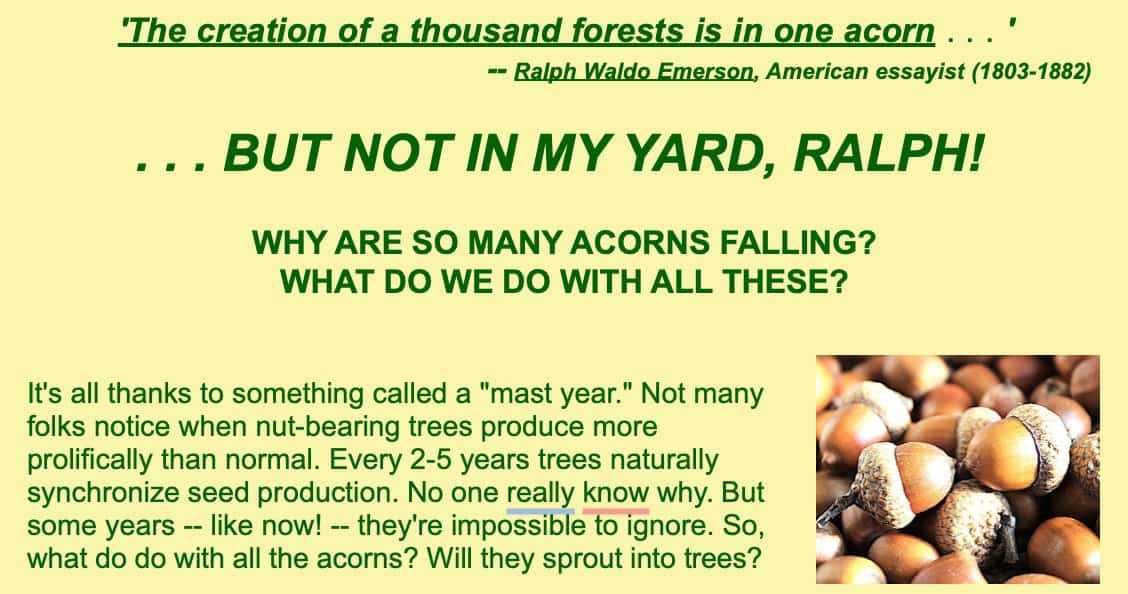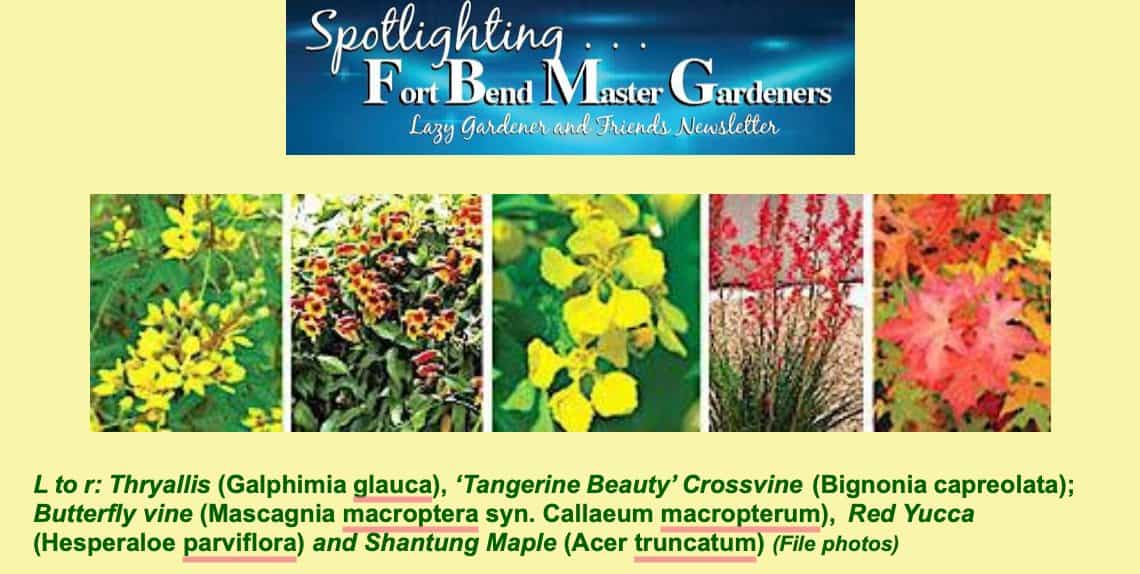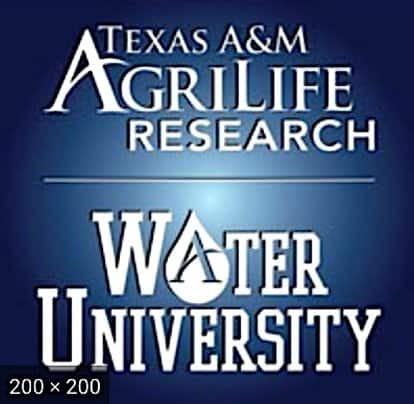

They could. Acorns are fruits that contain the SEEDS of new plants.That’s good if you want more trees. Bad if not. Especially in your compost pile. One solution: smash them. BEFORE putting them in a compost pile. Good answer — if you have just a few. Bigger challenge if you have SEVERAL MILLION!
Lawns are going dormant now, so acorns probably won’t affect leaf growth. But with delightfully-planted vegetable gardens (such as the hundreds affiliated with Urban Harvest around the Greater Houston area, it’s another matter.
SHARON STINSON, UH’s Classes Coordinator, reports some of their gardeners gather acorns into piles on concrete and run over them. Smushed, they are good for a heat-generated compost pile. Ditto for dried, tasteless pecans in shells, she adds. The folks she knows who rake and drop them right on the compost piles are also folks who turn piles frequently “…so they don’t have an opportunity to become baby trees.”
Some of Urban Harvests permaculture practitioners gather the acorns and make acorn flour. Personally, Sharon puts hers in “my heavily mulched pathways so that if they sprout, they are extremely easy to pull up.”
Since “below ground activity” is normally John Ferguson’s bailiwick, I asked him to chime in on this unusual onslaught. John’s notes:
“Yes, it appears we are having a mast year for many oak species. Many animals eat them from deer to turkeys. The acorns tend to drop before the leaves, hence they get covered by the leaves and many will germinate. Even if they germinate, many will die for various reasons. Nature likes to use a shotgun approach to ensure survival of the species.
In a compost pile it depends — for many reasons. In small backyard piles it will not get hot enough to kill them, so there is a possibility they will find the warm and moist conditions conducive to germination. Ones that are buried deeply in the pile will die from lack of sunlight or moisture. Others will just rot from the warm moist conditions.
Most likely only a small percentage will have the correct conditions to germinate. These can easily be pulled up when small. In a lawn when one mows, that generally kills small trees that recently germinated.
I just do not worry about them, except when I am outside and barefoot and I step on them!”
Hope some of this helps If you’re having an acorn avalanche in your yard! Any other suggestions?
* * *


Winter Color for Your Garden
By Sandra Gray
Fort Bend County Master Gardener
Compared to other seasons, winter can be a tough time for color in our gardens. However, it’s possible if you are flexible about what constitutes color. [Note: all plants in this article are Texas Superstars* because they are hardy, do well in most parts of Texas and are available at many local nurseries.]
Remember: green is a great alternative to brown and gray in your garden!
Thryallis (Galphimia glauca), a 4-6’ shrub, is evergreen in zones 9 and higher. It’s a reliable bloomer with yellow blossoms most of the year. ‘Tangerine Beauty’ Crossvine (Bignonia capreolata), a vine that can grow to 15’, attracts hummingbirds and butterflies with orange blooms throughout the growing season.
Butterfly Vine (Callaeum macropterum) is another choice. In early winter, its yellow blooms become salmon-colored pods that resemble butterflies.
Red Yucca (Hesperaloe parviflora) is a soft-tipped succulent with red flowers that attracts pollinators.
Shantung Maple (Acer truncatum) Add trees with colorful foliage or winter berries. is a great shade tree for smaller yards. In the fall, its foliage turns red and red-orange.

It is not uncommon to see Knock Out Roses blooming in winter. Tidal Wave™ Petunias, and other cool-season annuals can fill in until your spring blossoms return. Learn about Texas Superstars at texassuperstar.com/.
EDITOR’S NOTE: Fort Bend County Master Gardeners big SPRING FRUIT TREE SALE will be Sat., Feb. 10, 9am-noon, Building H, Fort Bend County Fairgrounds. fbmg.org/pct3.com/MBG. 713-274-4160. Free.
* * *

NEWS FROM THE WONDERFUL WORLD OF SOIL AND PLANTS # 266
Subject: Cation Exchange Capacity (CEC) Epson Salts
A question I often get is “What is CEC?” CEC stands for Cation Exchange Capacity and is a measurement of how many nutrients the soil can hold and release.
CEC is for elements with a positive electrical charge like magnesium (Mg+2), calcium (Ca+2), or potassium (K+1). This measurement is called “cation” exchange since it measures the ability of negatively charged soil particles (sand, silt, clay, organic matter, etc.) to bind up and then release positively charged elements like those above.
There is a similar measurement for negatively charged elements (sometimes called ions) called Anion Exchange Capacity (AEC). An ion may be a compound with a negative electrical charge like nitrate (NO-3) which is a molecule composed of oxygen and nitrogen. A few other negatively charged ions we experience in our soils are sulfate (SO -2) or chloride (Cl-1).
Note: Both CEC and AEC values are dependent of the acidity or alkalinity (pH) of the soil at time of measurement.
Most of us remember our grade school science where we were shown that the positive side of a magnet attracts the negative side. Conversely the negative side repels another negative side. Similarly in electricity, positive and negative charges attract each other and two of the same charge (negative or positive) repel each other.
This property affects the leaching potential in our soils and explains why
artificial fertilizers cause so much pollution. For example, anions like nitrate (NO-3) are repelled rather than attracted to soil surfaces with high cation exchange capacity since they are negatively charged which causes the nitrate to leach and pollute our streams and bays eventually creating dead zones in the ocean.
The next question one might ask is, “How are these nutrients (elements) in their ion form exchanged?”
Now biology comes into play. Root exudates from plants and soil microbes give off or produce positively charged hydrogen ions (H+1). If two hydrogen ions get close to a calcium ion on a soil particle, they kick it off and then they take its place on the soil particle. This allows the microbe or plant to easily absorb the calcium atom. The actual chemistry is a little more complex but this gives you an idea of what happens for plants to get needed nutrients.
A great Christmas present for gardeners is the following book: Teaming with Microbes, A Gardener’s Guide to the Soil Food Web, 2nd
Edition, by Jeff Lowenfels & Wayne Lewis, Timber Press, 2006, ISBN-13:978- 0-88192-777-1
This is the most complete book on the market about biological or organic methods in horticulture. It is written in a very easy to understand, non-technical format with lots of pictures illustrating the latest research is soil science. It is written for the average gardener and landscaper as an introduction that explains why organic methods work so well and how they help a person save time and money.
The book is written in two parts. The first part is a easy to understand very basic presentation on the science of soil biology. The second part take the ideas and concepts on the Soil Food Web that were introduced in part one and applies them to solving problems in our yards and gardens.
Subjects covered range from taking care of our soil, to compost and mulch choices. Also included is information on compost teas to natural weed control.
Each plant group from lawns and turfgrass, to annuals and vegetables, to shrubs perennials and trees are covered.
This book is Highly Recommended for all gardeners, landscapers or anyone taking care of a lawn or garden or anyone whom makes compost for use in a landscaping project.
A related issue I often hear from gardeners is, “my leaves were yellowing so I applied Epson salts but things are worse than before.”
In general, the application of calcium (Ca) loosens a soil and helps it be crumblier (better soil structure) and magnesium (Mg) tightens it and may create hardpan.
Research from the University of Missouri found that when a soil’s CEC was
saturated to 65 percent calcium (Ca) and 15 percent magnesium (Mg) and the rest being potassium and all the other minor and micronutrients, it produced excellent structure and grew high quality plants. Thus, the ratio of calcium to magnesium should be around 4-5:1.
If one has a soil with lots of clay, the Ca:Mg ratio may need to be 7:1 or more in extreme cases.
Epsom salt is also known as magnesium sulfate. It is a chemical compound is made up of magnesium, sulfur, and oxygen (MgSO4·7H2O) that easily dissolves in water. When one applies Epson salts and the magnesium is not needed, then too much magnesium ends up in the soil and makes it tighter.
This means less water and air can move through the soil which then hurts a plant growth and health. It also may create conditions that favor the growth of pathogens, as many diseases grow best in low aeration (oxygen) soils.
Often nutrients (elements) in excess cause more problems than a mild shortage.
* * *

SPONSORSHIP
If you are interested in becoming a sponsor, please contact us at 936-273-1200 or send an e-mail to: lazygardenerandfriends@gmail.com

ABOUT US
BRENDA BEUST SMITH WE KNOW HER BEST AS THE LAZY GARDENER . . . but Brenda Beust Smith is also:
- a national award-winning writer & editor
- a nationally-published writer & photographer
- a national horticultural speaker
- a former Houston Chronicle reporter
When the Chronicle discontinued Brenda’s 45-year-old Lazy Gardener” print column — started in the early ’70s as a fun side-project to reporting, it then ranked as the longestrunning, continuously-published local newspaper column in the Greater Houston area. The name, she says, is not just fun, it’s true. Brenda’s gradual sideways step from reporter into gardening writing led first to an 18-year series of when-to-do-what Lazy Gardener Calendars, then to her Lazy Gardener’s Guide book which morphed into her Lazy Gardener’s Guide on CD, which she now emails free upon request. Brenda became a Harris County Master Gardener and, over the years, served on theboards of many Greater Houston area horticulture organizations. She hosted local radio and TV shows, most notably a 10+-year Lazy Gardener specialty shows on HoustonPBS (Ch. 8) and her call-in “EcoGardening” show on KPFT-FM. For over three decades, Brenda served as Assistant Production Manager of the GARDEN CLUB OF AMERICA’S “BULLETIN” magazine. Although still an active broad-based freelance writer, Brenda’s main focus now is THE LAZY GARDENER & FRIENDS HOUSTON GARDEN NEWSLETTER with John Ferguson and Pablo Hernandez of Nature’s Way Resources. A native of New Orleans and graduate of St. Agnes Academy and the University of Houston, Brenda lives in Humble, TX, and is married to the retired Aldine High School Coach Bill Smith. They have one son, Blake. Regarding this newsletter, Brenda is the lead writer, originator of it and the daily inspiration for it. We so appreciate the way she has made gardening such a fun way to celebrate life together for such a long time.
JOHN FERGUSON John is a native Houstonian and has over 27 years of business experience. He owns Nature’s Way Resources, a composting company that specializes in high quality compost, mulch, and soil mixes. He holds a MS degree in Physics and Geology and is a licensed Soil Scientist in Texas. John has won many awards in horticulture and environmental issues. He represents the composting industry on the Houston-Galveston Area Council for solid waste. His personal garden has been featured in several horticultural books and “Better Homes and Gardens” magazine. His business has been recognized in the Wall Street Journal for the quality and value of their products. He is a member of the Physics Honor Society and many other professional societies. John is is the co-author of the book Organic Management for the Professional. For this newsletter, John contributes articles regularly and is responsible for publishing it.
PABLO HERNANDEZ Pablo Hernandez is the special projects coordinator for Nature’s Way Resources. His realm of responsibilities include: serving as a webmaster, IT support, technical problem solving/troubleshooting, metrics management and quality control. Pablo helps this newsletter happen from a technical support standpoint.
Download the Newsletter with Our Events Calendar Below!

